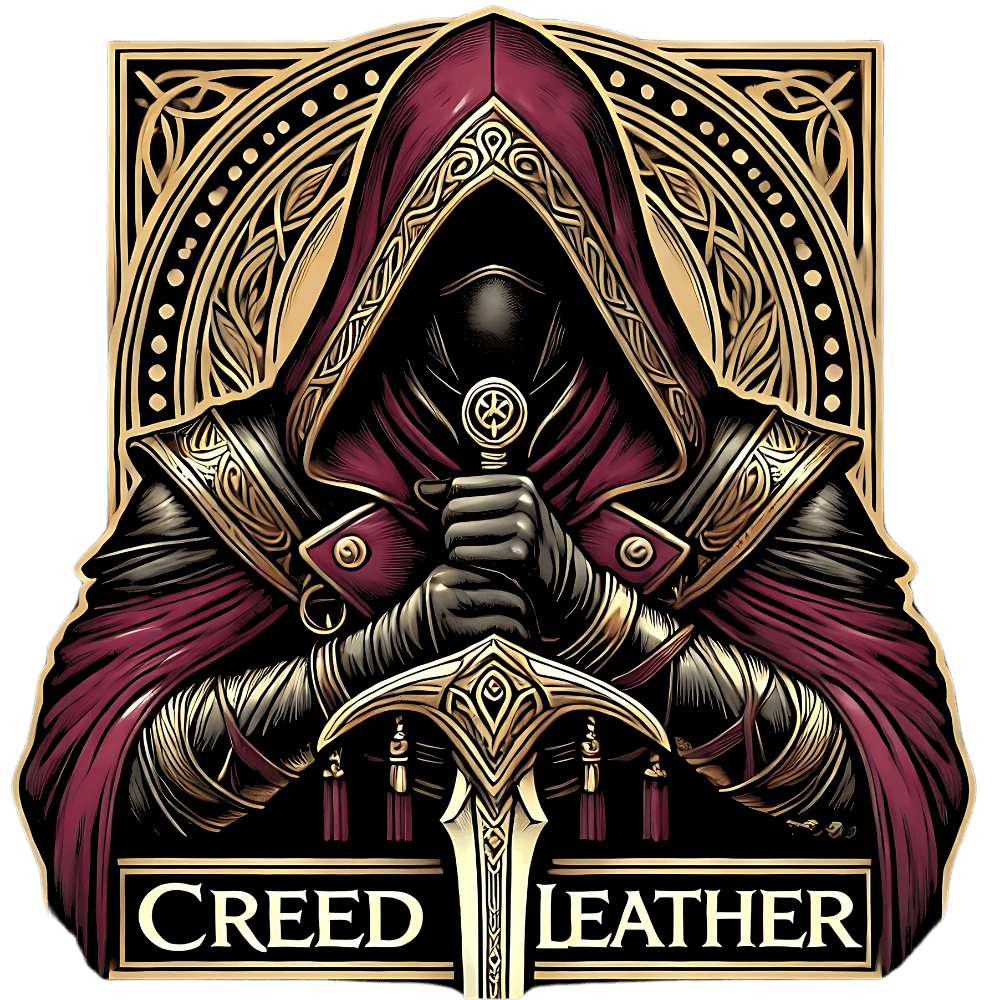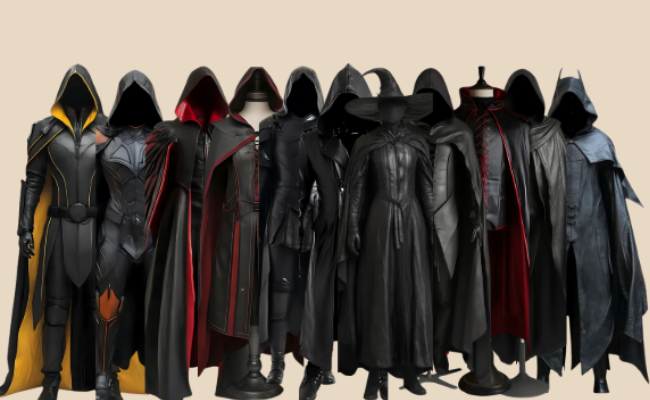Historical Roots of Fantasy Leather Costume Design

Fantasy costumes are deeply rooted in history. Whether in video games, films, books, or cosplay, the aesthetic choices that define fantasy characters are often drawn from centuries of traditional craftsmanship and cross-cultural evolution. Leatherwear in particular stands out as a defining element in fantasy settings—an enduring material that ties imagination to historical reality.
This in-depth exploration reveals how various civilizations, eras, and cultural styles have shaped what we now recognize as fantasy armor, leather garments, and character design. From medieval Europe knights armour to the ceremonial garb of traditional tribal clothing, the past continues to shape the visual language of fantasy worlds.
Why History Matters in Fantasy Design

Fantasy settings appear disconnected from the real world, but they often rely on historical styles to lend authenticity and depth. Leatherwork, in particular, provides a rich opportunity to reflect historical realities while exploring imaginative possibilities. This is why so many fantasy creators use historical gothic fashion ancient militaria, and folk traditions to shape their characters’ appearances.
Costumes become symbolic expressions of status, culture, and personality. For warriors, nomads, mages, or nobles, leather designs communicate power, experience, and aesthetic lineage. Understanding the historical sources behind these designs helps explain why fantasy fashion looks the way it does.
Medieval Europe: The Bedrock of Fantasy Armor
The Function and Form of Knightly Gear

The most visible influence on fantasy leather designs comes from medieval Europe knights armour. During the High and Late Middle Ages, warriors wore layered protection that often included leather under-armor, reinforced jerkins, and embossed gear designed for both utility and intimidation.
-
Gambesons, often leather-padded tunics, acted as a cushion beneath chainmail.
-
Brigandines, sleeveless vests reinforced with metal plates, were often constructed with outer layers of leather.
-
Belts, pouches, and greaves crafted from leather offered both flexibility and protection.
In many armor fantasy settings, these medieval elements are reflected in how characters dress. Game titles considered among the best fantasy RPGs of all time often depict knights, soldiers, and rangers in gear that closely mimics this style—layered, worn, and grounded in historical realism.
Aesthetic Legacy
Designers often replicate the aesthetic of historical gothic fashion seen in late medieval court armor—characterized by pointed edges, elaborate fluting, and sculpted contours. These details are especially visible in female fantasy armor, where historical design merges with stylized embellishments.
The Rugged Realism of Viking Culture
Functional Design for Survival
Viking culture contributed a powerful visual legacy to fantasy leather designs. Practical, durable, and battle-ready, Viking gear was crafted to suit cold climates and harsh terrain. Leather tunics, fur-lined cloaks, and broad belts are some of the most recognizable design elements.
Fantasy characters modeled after northern tribes or barbarian cultures frequently wear gear that reflects Viking culture:
-
Simple but robust leather chest wraps
-
Shoulder guards fastened with brooches
-
Asymmetrical tunics with fur and raw edges
These garments reflect not only a history of survival and warfare but also a cultural identity centered on strength and endurance.
Spiritual and Symbolic Elements
Vikings also adorned their gear with symbolic embellishments. Leather bracers, belts, and shoulder pieces might feature runic carvings, animal motifs, or knotwork that connects the wearer to mythic power—design traits echoed in armor fantasy styles today.
The Renaissance Period: Expression and Detail
Art Meets Leatherwork

The renaissance period dress style marked a significant shift in both form and function. This era emphasized humanism, beauty, and individual expression. Leatherworkers advanced the art of tooling, embossing, and painting, creating intricate designs with scrollwork, florals, and mythological themes.
Fantasy characters from high courts, magic guilds, or merchant cities often wear richly detailed costumes that draw inspiration from renaissance period dress. Leather collars, corsets, cuffs, and paneling reflect a heightened sense of artistry that emerged during this period.
-
Tooled leather doublets
-
Embroidered belts and gloves
-
Layered sashes and cloaks
These elements are particularly visible in female fantasy armor, where elegance and combat-readiness coexist through refined materials and tailored silhouettes.
The Influence of Ancient Greek Armor

Precision, Discipline, and Symbolism
Ancient Greek armor worn by hoplites and mythological figures alike—remains a key influence on fantasy design. Leather was often used for protective skirts (pteryges), sandals, and shield straps.
Key elements of ancient Greek armor include:
-
Segmented leather skirts for mobility
-
Chest plates molded to the human form
-
Mythical iconography such as gorgons and gods
In fantasy design, these features appear in characters inspired by classical heroism and mythology. The influence is especially prominent in fantasy gladiators, demigods, or arena champions.
Tribal and Nomadic Traditions
Adaptability and Identity

The clothing of nomadic and tribal cultures—from the Scythians to indigenous North American nations—focused on mobility, durability, and cultural storytelling. Traditional tribal clothing used leather for practical purposes but also as a canvas for symbolic representation.
Design elements in traditional tribal clothing include:
-
Fringes, beadwork, and painted patterns
-
Leather cloaks and wraps for temperature control
-
Holistic integration of nature (bones, feathers, plant dyes)
These influences are visible in tribal leather jacket designs seen in fantasy, which combine mobility and mysticism. In some genres, these jackets are associated with shamanic characters or desert rangers, conveying spiritual depth and adaptability.
Fantasy Elves and Cultural Hybridity
Nature-Inspired Elegance

The fantasy elf costume is another realm where historical elements blend into imaginative aesthetics. Elves are often portrayed as deeply connected to nature, and their clothing reflects that through lightweight, fitted leather garments that allow silent movement through forests or magical realms.
Key elements in the fantasy elf costume archetype include:
-
Leaf-like leather pauldrons and bracers
-
Sinewy, elongated designs that mimic organic forms
-
Embossed symbols representing trees, animals, or elements
These design choices often borrow from traditional craftsmanship and indigenous aesthetics, merging elegance with mysticism. Elven armor and clothing are frequently designed to appear ancient yet timeless, echoing the long lifespan and wisdom of these fictional beings.
Cross-Cultural Influences in Modern Fantasy
Hybridization and Worldbuilding
One of the most fascinating aspects of fantasy design is how it freely blends cultures, time periods, and stylistic conventions. For instance:
-
A leather corset might reflect renaissance dress, while also incorporating tribal leather jacket fringes.
-
A warrior’s boots could be inspired by Viking culture but designed with motifs from ancient Greek armor.
-
A scout’s armor might feature utility pouches based on traditional tribal clothing and chestplates reminiscent of medieval Europe knights armour.
This cross-cultural hybridity makes fantasy fashion distinct. It creates a visual language that feels familiar yet fantastical—allowing characters to exist in imagined timelines grounded by real-world references.
Craftsmanship Techniques That Define the Genre
Methods Rooted in History

Fantasy leather designs do more than replicate history—they reflect the methods and values of traditional craftsmanship. Techniques passed down through generations of artisans continue to shape the look and feel of fantasy costumes.
Core techniques include:
-
Vegetable tanning: A natural method of preserving hides using plant materials
-
Wet forming: Shaping leather to fit molds or body forms
-
Tooling and embossing: Creating designs through carving and pressing
-
Burnishing: Smoothing edges and surfaces for longevity and polish
These techniques give leather its signature visual depth—worn, aged, and deeply textured. Whether on a fantasy elf costume, a ranger’s cloak, or an armored glove, the handiwork reflects authenticity and detail.
Influence of Fantasy RPGs and Popular Media
Cultural Echoes in Gaming and Fiction

Some of the best fantasy RPGs of all time like The Witcher, Elden Ring, Skyrim, and Dragon Age have pushed the boundaries of fantasy design while staying rooted in historical references.
Their leather costumes often show:
-
Worn textures indicating past battles
-
Detailed layering that mimics armor fantasy
-
Gender-sensitive armor, especially in female fantasy armor, where protection meets stylistic elegance
These visual themes continue to influence cosplay, fan art, literature, and even stage productions. Fantasy RPGs act as modern storytellers, keeping history alive through character design.
Myth, Ritual, and Symbolic Power
The Story Beneath the Stitching
Fantasy leather design often incorporates symbolic motifs derived from mythologies around the world. These symbols turn armor and clothing into objects of belief, power, and personal meaning.
Common motifs include:
-
Sun and moon cycles etched into bracers
-
Totem animals burned or carved into cloaks
-
Runes and sigils representing elements, gods, or spirits
These additions transform costume design from aesthetic to narrative. A character’s leather gear can now reveal lineage, faith, or supernatural alignment—adding layers of meaning for both creators and audiences.
Conclusion: From Ancestry to Imagination
Fantasy leather designs are not arbitrary—they are the result of centuries of traditional craftsmanship, symbolic expression, and cultural storytelling. Whether borrowing from Viking culture, adapting the silhouettes of renaissance period dress, or evoking the soul of ancient Greek armor, each piece of costume speaks to a deeper lineage.
Through detailed research and thoughtful design, fantasy creators breathe new life into the past. They turn historical references into immersive worlds, where a tribal leather jacket or a fantasy elf costume doesn’t just clothe a character—it tells a story.
By studying history, designers and storytellers can imagine futures that feel tangible, meaningful, and rich with ancestral wisdom. Leather, in all its forms, remains a canvas where culture, fantasy, and identity meet.



